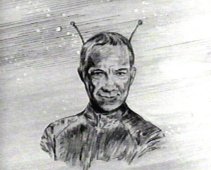
MY FAVORITE MARTIAN
&Popular Culture of 1963

The Golden Anniversary of My Favorite Martian
John L. Greene’s script for the pilot of My Favorite Martian is dated Oct. 1,1962.The pilot was filmed in December of 1962 and bought by CBS in January 1963, making it 50 years since the creation of the show.
In 1963, the TV series My Favorite Martian took its place on
CBS-TV’s Sunday night schedule, as the network hoped to repeat its success with another "fish-out-of-water’ premise that had been so overwhelmingly successful for its 1962 comedy, The Beverly Hillbillies.
To put the series in context, prior to My Favorite Martian’s premiere on Sept 29, 1963, the only other regular prime time comedy to use special effects was the 1953 TV show, Topper, which in turn, was derived from the Topper movies of 1937 and 1939. The Topper premise was based on the Thorne Smith book about a veteran New York banker named Cosmo Topper being placed in unlikely predicaments when he becomes the only one who can see and hear fun loving ghosts George and Marian Kerby (and their St. Bernard dog, Neil). In fact, Topper is once mentioned in a "Martian" episode (Man or Ameba).
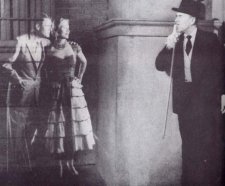 …Robert Sterling, Anne Jefferies & Leo G.Carroll in Topper
…Robert Sterling, Anne Jefferies & Leo G.Carroll in Topper
The Topper TV series used a fair share of special effects to demonstrate invisibility and it had a popular two year network run. Still, while The Twilight Zone (also mentioned once on MFM) and The Outer Limits offered sci-fi/fantasy drama, no other comedy series followed to be part of the fantasy genre. So, by 1963, the TV landscape was very much open to a half-hour situation comedy with a science-fiction theme. The timing was right for My Favorite Martian.
The TV series contained occasional references to the world of 1963, especially in the pilot episode with the spaceship’s encounter with the USA’s X-15 rocket plane, a high-altitude test plane that was launched from beneath the starboard wing of a B-52 bomber
.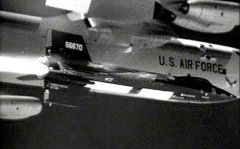 …………
…………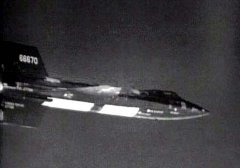
In reality, this test plane was technically considered a spacecraft since it could fly above the Earth’s atmosphere for several minutes, and two such X-15 flights from Edwards AF Base took place in 1963; one in June and another flight in August, which set a world record for that time by achieving an altitude of 67 miles. In subsequent flights, the X-15 reached a record setting speed of 4,520 mph. This remarkable plane, with its greatly honored test pilots, continued making flights until 1968.
In the TV story line for My Favorite Martian, the X-15 is reported to have been flying at 4,332.45858 mph when it is overtaken and passed by the Martian’s ship (doing over 9,000 mph), resulting in the alien craft being reported as a "flying saucer".
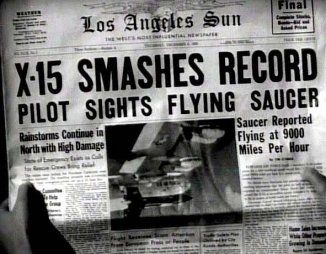 ….Tim’s headline story on the day he meets the Martian.
….Tim’s headline story on the day he meets the Martian.
Continuing to look at the reality of 1963, how was data about Mars collected at the time? Information was regularly obtained by earth-bound spectroscopic readings and the best visual observations were limited to those of 100 inch telescopes. One innovative attempt to find out more about the Red Planet came on March 1, 1963, when the USA had a telescope carried 77,000 feet high by a balloon to try and detect data to see if Mars could support life.
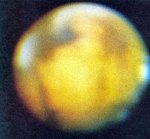 Mars through a 100 inch telescope
Mars through a 100 inch telescope
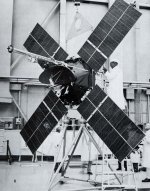 Mariner 4……………..
Mariner 4……………..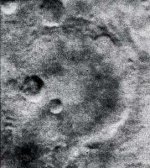 Mars from Mariner 4 (1965)
Mars from Mariner 4 (1965)
In 1963 the US race for space with the Russians was a top news story and NASA was still conducting one-manned capsule flights in the Mercury program. By 1965, NASA’s two-man Gemini astronaut program is mentioned in the "Who’s Got a Secret"? script. Also in a 1965 episode ("Tim the Mastermind") there is an allusion to the 1965 USA Mars probe Mariner 4, which, on July 14, 1965 became the first spacecraft to ever send back photos from another planet. Its images revealed that there were craters on Mars.
My Favorite Martian
began filming during the summer of 1963 and occasionally referenced the American culture of that time. In "A Loaf of Bread…and Peaches" Martin says, "Please Tim, I rather not do it myself!", which was a reference line to a popular and irritating series of TV commercials for Anacin pain reliever, where someone with a headache would edgily snap to a family member, "Please, I’d rather do it myself!"Politics are mentioned ("The Awful Truth", Oct 27, 1963) with an elder Councilmen trying to be associated as "part of The New Breed", a slogan for the young politicians of the Kennedy era
. By 1965, a script has a character remark, "Goodbye to ‘The Great Society’" ("The O’Hara Caper") a reference to a slogan of the Lyndon Johnson administration.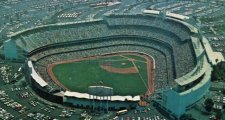 ….Dodger Stadium in Chavez Ravine
….Dodger Stadium in Chavez Ravine
Having continued their winning streak from the previous year in their new ballpark, The Los Angeles Dodgers won the 1963 World Series, and so it was natural that a few references were made about the championship Dodger team in the first season of the show. Baseball is referenced again in the episode "Rx for a Martian", when, while going through souvenirs of Earth, Martin notes a baseball autographed by Bo Belinsky, a star rookie pitcher for the Los Angeles Angels.

In that same show he decides to keep an Elvis record as a souvenir, and Tim mentions a Twist contest, still a popular dance craze at that time. By the end of the first season the Beatles are mentioned, and in the "My Aching Antennae" episode, a college student is wearing a Beatle wig. (A trivia note: My Favorite Martian was the lead-in show for Ed Sullivan at the time of all The Beatles’ famous appearances on that variety show). At the movies, the much publicized wide-screen version of Cleopatra starring Elizabeth Taylor was the top grossing film of 1963 and she, Sophia Loren and Brigitte Bardot led the list of Hollywood’s most alluring actresses. All were mentioned in MFM scripts, as was James Bond, in 1965.
As a general rule, TV series at that time refrained from having too many topical references in their scripts in order to avoid being "dated" in reruns, and My Favorite Martian basically followed those guidelines. But it is worth noting that The Beatles were mentioned in various moments during all 3 seasons, demonstrating that certain cultural references were just too popular to be ignored.
 Feb.23, 1964
Feb.23, 1964
e-mail:
jhharison@gmail.com
This website is non-profit for fan and educational purposes only. No infringement of rights
is meant or implied. All copyrighted quotes and photographs are held by their respective publications and companies. Original screen capture images and text found on this site may not be reproduced without prior consent of JH Harison.